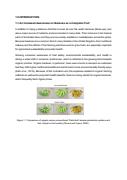1.0 INTRODUCTION 1.1 An Increased Awareness on Bananas as a Complete Fruit In addition to being a delicious fruit that is loved all over the world, bananas (Musa spp.) are also a major source of nutrients and are included in many diets. Their roots are in the tropical parts of Southeast Asia, and they are now widely available in marketplaces across the globe. Because bananas are a common food in many families in the United Kingdom, their nutritional makeup and the effects of the farming practices used to grow them are especially important for agricultural sustainability and public health. Growing consumer awareness of food safety, environmental sustainability, and health is driving a wider shift in consumer preferences, which is reflected in the growing trend towards organic produce. Organic bananas, in particular, have seen a boom in demand as customers feel they offer higher nutritional benefits and are farmed in more environmentally friendly ways (Kahl et al., 2019). Because of this inclination and the expenses related to organic farming methods as well as the purported health benefits, there is a rising market for organic bananas, which frequently fetch higher prices. Figure 1.1 Comparison of organic versus conventional ‘Prata Anã’ banana production systems and their impact on fruit quality (Oliveira and Lopes, 2020).
